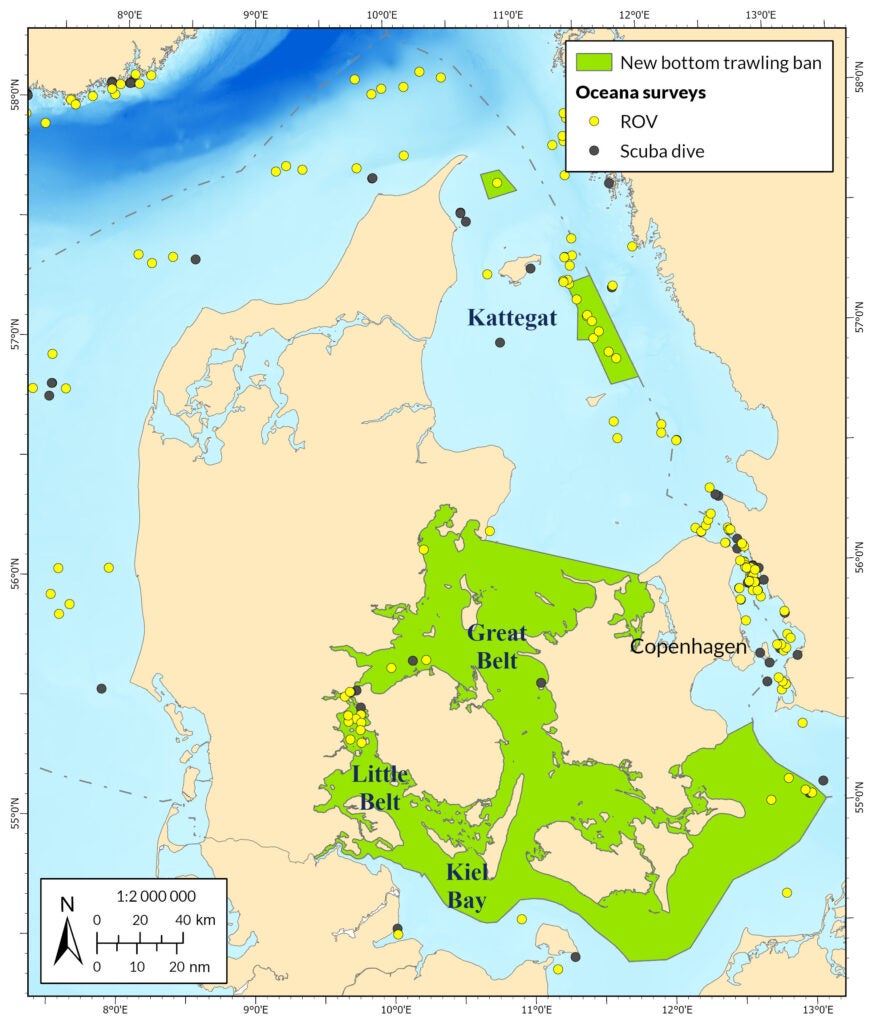February 14, 2025
How Denmark’s bottom trawling ban could benefit marine conservation
In a bid to restore its marine environment, Denmark has announced a proposal to expand its ban on bottom trawling, which will cover a total area of around 23,000 km², equivalent to 17% of its sea area. Currently, fishing with bottom trawling gear is prohibited in 4,864km² of Danish waters. This proposed expansion marks a significant step towards protecting marine life and habitats in Danish waters, which consist of the North Sea, the Baltic Sea, the Skagerrak, the Kattegat, and various other straits and basins.
The importance of the proposal
The seabed and benthic ecosystems (those that lie close to the sea bottom) in Danish waters have long suffered from activities like trawling, overexploitation, and sand dredging. If enacted, this proposal would prohibit fishing with bottom trawling gear across the entire Belt Sea, offering critical protection to vulnerable marine habitats. In 2015 , The Danish Nature Agency, had identified bottom trawling as one of the main reasons why Danish waters lacked “Good Environmental Status” according to EU environmental legislation.
Denmark’s marine environment
Denmark’s Little Belt, a marine strait between the Jutland mainland and the island of Fyn, is a prime example of the diverse habitats this proposal aims to safeguard. Alongside the Great Belt, it forms the Belt Sea, an area known for its biodiversity and unique ecosystems.
One feature that stands out is the common eelgrass (Zostera marina), documented in the Little Belt’s shallow coastal waters during Oceana’s expeditions . Eelgrass meadows provide essential shelter for marine species, keep the seabed in place with their roots, and act as significant carbon sinks, contributing to climate regulation. However, their distribution is declining across Europe, making it even more crucial to preserve them.
The strong currents in the Little Belt also create ideal conditions for unique habitats, including macroalgae and benthic communities. These habitats are vital for maintaining the biodiversity of the region.
The deep Kattegat is also a key biodiversity area. It is one of the few places in Denmark where some important habitats still exist, such as sea pen fields and extensive haploop communities that are important for other crustaceans, annelids, and fish (cod, pout, flounder, etc.). These deep areas host some types of reef, including rocky bottoms, sponge aggregations and horse mussel beds, which in turn act as natural shelters for marine species, helping fish populations to recover and thrive.
Oceana’s contribution

Since 2016, Oceana’s at-sea expeditions onboard the Ranger have identified areas requiring further protection. In a two-month at-sea expedition to the Kattegat in 2011 , Oceana used advanced tools like its remotely operated vehicle (ROV) to capture rare footage of the deep Kattegat trench, revealing the rich biodiversity of this area for the first time. With the ROV, we were able to find soft bottom habitats, including rare Haploop and horse mussel communities, beautiful sea pens with burrowing megafauna, and unusual sponge aggregations.
A coalition of several Danish NGOs, and Oceana, had published a report, proposing protection of the Little Belt and the surrounding areas. Oceana’s proposal included a much larger area, covering four of the new sites proposed under the government’s current plan.
Potential benefits of the proposal
If approved, this ban would:
- Protect and restore critical habitats like eelgrass meadows, macroalgae, and benthic communities.
- Protect marine biodiversity by reducing destructive fishing practices.
- Enhance climate resilience by preserving carbon-storing ecosystems.
- Promote sustainable fisheries by allowing depleted fish stocks to recover.
The way forward
Denmark’s bottom trawling ban proposal represents a bold step forward in the fight to restore its marine ecosystems and to support its future national restoration plan. Advocacy efforts, combined with scientific research, have laid a strong foundation for this policy. As the Danish parliament debates the proposal, we remain hopeful that it will be upheld and look forward to seeing these vital areas protected for generations to come.
Join the Movement to End Bottom Trawling in Europe’s Protected Waters by signing this petition

